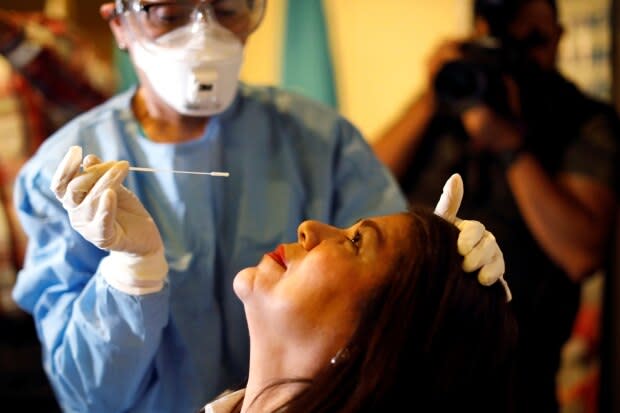'We're at a decisive point': Hospitals ramp up pandemic plans for COVID-19

Canadian hospitals are gearing up their disaster preparedness plans in anticipation of the next phase of the COVID-19 epidemic, from containment to mitigation.
Current efforts to control the epidemic focus on keeping community spread at bay. If it's declared a pandemic, that will shift to slowing down the spread of the virus in populations where it's taken root.
In a pandemic, large numbers of people fall sick, though the disease may or may not be severe.
The World Health Organization is calling on governments, health care and other institutions as well as individuals to prepare.
"We're at a decisive point," WHO Director-General Tedros Adhanom Ghebreyesus told reporters on Thursday. "For the past two days, the number of new cases reported in the rest of the world has exceeded the number of new cases reported from China."
Dr. Michael Gardam, an infectious disease specialist and chief of staff at Humber River Hospital in Toronto, is a veteran of SARS and H1N1 and is watching this outbreak closely.

"The tone has changed," Gardam said. "We need to shift our thinking into this is going to become a problem within Canada within a matter of weeks to months."
Currently, health care workers in Canada screen people who show up with flu-like symptoms and say they've travelled to any of seven places — China, Japan, Hong Kong, Italy, Iran, Singapore and South Korea.
"At some point we'll have to shift into just screening people that are travelling, and it doesn't necessarily matter to where they're actually travelling from," Gardam said.
WHO said China's experience shows aggressive early measures can prevent the virus from gaining a foothold, and there hasn't been widespread community transmission — the spread from one person to another when there was no known exposure to the virus through travel or close contact with an infected individual.
But the U.S. Centers for Disease Control and Prevention has reported a case of COVID-19 in California suspected of being the first person-to-person transmission in the general public in that country, which has alarmed U.S. health officials because it raises the possibility of widespread transmission, already suspected in Italy, Germany and South Korea.
WATCH: Infectious disease doctor explains what's happening with global spread of COVID-19
"This suggests the virus is out there in the community," said Dr. Dean Blumberg of University of California Davis Medical Center. "We don't know who might be carrying it. We don't know who we could get it from.
"There's probably other cases in the community that we don't know about."
Ontario's chief medical officer of health, Dr. David Williams, said the province is preparing for the possibility of community transmission.
"Right now, we're doing 30 to 40 tests," Williams said. "Our lab can do 1,000. But we can't rest on that. What if we have to go to 2,000 or 3,000? How do we prepare for that?"
Gardam said it is time to expand testing.
"I think at this stage, we should be testing people without a travel history who are sick enough to be admitted and who do not have another obvious cause of their illness. This is what they eventually did in California that allowed them to find their case."
Medical facilities also have to take stock of their facilities, equipment and supplies to see where they are lacking: masks, gloves and gowns for health care workers; testing supplies; the ability to isolate patients.
Federal pandemic stockpiles include medical equipment and supplies, such as ventilators and masks, as well as standard medications like antibiotics and antivirals, the Public Health Agency of Canada said in a statement to CBC News.
Bracing for resource strain
Dr. Anand Kumar teaches medical microbiology at the University of Manitoba and works as a critical care physician in Winnipeg, where he sounded an alarm about lack of ventilators to care for patients during the H1N1 pandemic in 2009.
Kumar expects the risk in terms of severity of illness in the potential COVID-19 pandemic will be similar to H1N1.
In 2009, many places found a major "choke point" was a lack of resources in intensive care units, including nurses.
"The pressures on the health care system in terms of resources are likely to be similar," Kumar said.

Although H1N1 and Ebola offered head starts in developing contingency plans, most hospitals already operate at full capacity, particularly during flu season.
Gardam said if an epidemic were to go on for several months, hospitals would have to start looking at how to free up beds by putting people in "unusual places" and stopping elective procedures.
Hospital preparations should also include additional training: having staff practise putting on and taking off preventative equipment safely, said Nancy Johnson, a retired occupational health and safety specialist with the Ontario Nurses' Association in Sudbury.
"Safety of health care workers right now is not negotiable," Johnson said. "If they're not safe, none of us are."
Masks and gloves in short supply
Some family physicians have already found supplies running short, including masks to put on sick patients.
I "check the mail every day for N95 masks, which have yet to arrive," said Dr. Iris Gorfinkel, a family physician in Toronto. "[And] more gloves, hopefully. We don't have them or hand sanitizer."
Health Minister Patty Hadju encouraged Canadians to prepare as they would for a storm.
"First of all, making sure that you do have enough supplies so if someone in your family becomes ill, if you yourself become ill, that you have what you need to survive for a week or so without going outside," Hadju said.
To help, individuals can do their best to stay healthy and keep up to date as the epidemic evolves. The standard prevention measures include washing hands frequently, avoiding touching your face, getting a flu shot, staying home when sick and coughing and sneezing into a tissue or your elbow.

